
|

|
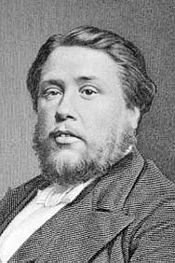
Charles Haddon Spurgeon, commonly C.H. Spurgeon, (June 19, 1834
– January 31, 1892) was a British Reformed Baptist preacher who remains highly influential amongst Christians of different
denominations, among whom he is still known as the "Prince of Preachers." He also founded the charity organization now known
as Spurgeon's, that works worldwide with families and children, as well as a famous theological college which after his death
was called after him: Spurgeon's College. His sermons were translated into many languages in his lifetime.
Early beginnings
Born in Kelvedon, Essex, Spurgeon's conversion to Christianity came
on January 6, 1850 at the age of fifteen. On his way to a scheduled appointment, a snow storm forced him to cut short his
intended journey and to turn into a Primitive Methodist chapel in Colchester where, in his own words: "God opened his heart
to the salvation message." The text that moved him was Isaiah 45:22 - "Look unto me, and be ye saved, all the ends of the
earth, for I am God, and there is none else."
Later that year, on April 4, 1850, he was admitted to the church
at Newmarket. His baptism followed on May 3 in the river Lark, at Isleham. Later that same year he moved to Cambridge. He
preached his first sermon in the winter of 1850 / 1851 in a cottage at Teversham, Cambridge; from the beginning of his ministry
his style and ability were considered to be far above average. In the same year, he was ordained as pastor of the small Baptist
church at Waterbeach, Cambridgeshire, where he published his first literary work: a Gospel tract written in 1853.
In
April 1854, after preaching three months on probation and just four years after his conversion, Spurgeon, then only 19, was
called to the pastorate of London's famed New Park Street Chapel, Southwark (formerly pastored by the Particular Baptists
Benjamin Keach, theologian John Gill, and John Rippon). This was the largest Baptist congregation in London at the time, although
it had dwindled in numbers for several years. Spurgeon found friends in London among his fellow pastors, such as William Garrett
Lewis of Westbourne Grove Church, an older man who along with Spurgeon went on to found the London Baptist Association. Within
a few months of Spurgeon's arrival at Park Street, his powers as a preacher made him famous. The following year the first
of his sermons in the "New Park Street Pulpit" was published. Spurgeon's sermons were published in printed form every week,
and enjoyed a high circulation. By the time of his death in 1892, he had preached almost thirty-six hundred sermons and published
forty-nine volumes of commentaries, sayings, anecdotes, illustrations, and devotions.
Immediately following his fame was controversy.
The first attack in the Press appeared in the Earthen Vessel in January 1855. His preaching, although not revolutionary in
substance, was a plain spoken and direct appeal to the people using the Bible to provoke them to consider the claims of Jesus
Christ. Critical attacks from the media persisted throughout his life.
The congregation quickly outgrew their building, moved to Exeter
Hall, then to Surrey Music Hall. In these venues Spurgeon frequently preached to audiences numbering more than 10,000 —
all in the days before electronic amplification. At twenty-two Spurgeon was the most popular preacher of the day.
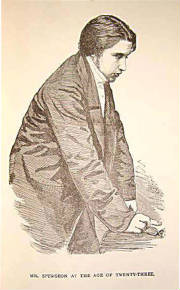
On January 8, 1856, Spurgeon married Susannah, daughter of Robert
Thompson of Falcon Square, London, by whom he had twin sons, Charles and Thomas September 20, 1856. At the end of that eventful
year, tragedy struck on October 19, 1856 as Spurgeon was preaching at the Surrey Gardens Music Hall for the first time. Someone
in the crowd yelled, "Fire!" and there was a panic and a stampede that left several dead. Spurgeon was emotionally devastated
by the event and it had a sobering influence on his life. He struggled against clinical depression for many years and spoke
of being moved to tears for no reason known to himself.
Walter Thornbury later wrote in "Old and New London" (1897) describing
a subsequent meeting at Surrey:“ a congregation consisting of 10,000 souls, streaming into the hall, mounting the
galleries, humming, buzzing, and swarming-a mighty hive of bees-eager to secure at first the best plates, and, at last, any
place at all. After waiting more than half an hour-for if you wish to have a seat you must be there at least that space of
time in advance .. Mr. Spurgeon ascended his tribune. To the hum, and rush, and trampling of men, succeeded a low, concentrated
thrill and murmur, of' devotion, which seemed to run at once, like an electric current, through the breast of every one present,
and by this magnetic chain the preacher held us fast bound for about two hours. It is not my purpose to give a summary of
his discourse. It is enough to say of his voice, that its power and volume are sufficient to reach every one in that vast
assembly; of his language that it is neither high-flown nor homely; of his style, that it is at times familiar, at times declamatory,
but always happy, and often eloquent; of his doctrine, that neither the 'Calvinist' nor the ' Baptist' appears in the forefront
of the battle which is waged by Mr. Spurgeon with relentless animosity, and with Gospel weapons, against irreligion, cant,
hypocrisy, pride, and those secret bosom-sins which so easily beset a man in daily life; and to sum up all in a word, it is
enough to, say of the man himself, that he impresses you with a perfect conviction of his sincerity. ”
Still the work went on. A Pastors' College was founded in 1857 by
Spurgeon and was renamed Spurgeon's College in 1923 when it moved to its present building in South Norwood Hill, London. At
the Fast Day, October 7, 1857 he preached to the largest crowd ever: 23,654 people at The Crystal Palace in London. Spurgeon
noted:“ In 1857, a day or two before preaching at the Crystal Palace, I went to decide where the platform should
be fixed; and, in order to test the acoustic properties of the building, cried in a loud voice, "Behold the Lamb of God, which
taketh away the sin of the world." In one of the galleries, a workman, who knew nothing of what was being done, heard the
words, and they came like a message from heaven to his soul. He was smitten with conviction on account of sin, put down his
tools, went home, and there, after a season of spiritual struggling, found peace and life by beholding the Lamb of God. Years
after, he told this story to one who visited him on his death-bed.
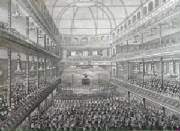
The Metropolitan Tabernacle Pulpit
On March 18, 1861 the congregation moved permanently to the newly
constructed purpose-built Metropolitan Tabernacle at Elephant and Castle, Southwark, seating five thousand people with standing
room for another thousand. The Metropolitan Tabernacle was the largest church edifice of its day and can be considered a precursor
to the modern "megachurch." It was at the Tabernacle that Spurgeon would continue to preach several times per week until his
death 31 years later. He never gave altar calls at the conclusion of his sermons, but he always extended the invitation that
if anyone was moved to seek an interest in Christ by his preaching on a Sunday, that they could come to meet with him at his
vestry on Monday morning. Without fail, there was always someone at his door the next day. He wrote his sermons out fully
before he preached, but what he carried up to the pulpit was a note card with an outline sketch.
Stenographers would take down the sermon as it was delivered, then
Spurgeon would have opportunity to make revisions to their transcripts the following day for immediate publication. His weekly
sermons that sold for a penny each were widely circulated and still remain one of the all-time best selling series of writings
published in history.
Besides sermons, Spurgeon also wrote several hymns and published
a new collection of worship songs in 1866 called "Our Own Hymn Book". It was mostly a compilation of Isaac Watts' Psalms and
Hymns that had been originally selected by John Rippon, a Baptist predecessor to Spurgeon. What is remarkable compared to
most modern practices, is that the singing in the congregation was exclusively a cappella under his pastorate. It is noteworthy
that thousands heard the preaching and were led in the singing without any amplification of sound that exists today. Hymns
were a subject that he took seriously. While Spurgeon was still preaching at New Park Street, a hymn book called "The Rivulet"
was published. Spurgeon's first controversy arose due to his critique of its theology, which was largely deistic. At the end
of his review, Mr Spurgeon warned:“ We shall soon have to handle truth, not with kid gloves, but with gauntlets,
– the gauntlets of holy courage and integrity. Go on, ye warriors of the cross, for the King is at the head of you. ”
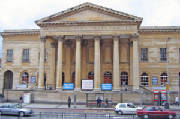
On June 5, 1862, Spurgeon also challenged many paedobaptist Christian
leaders when he preached against infant baptism in a famous sermon called "Baptismal Regeneration". However, Spurgeon did
build bridges across denominational lines as well. It was during this period at the new Tabernacle that Spurgeon found a friend
in James Hudson Taylor, the founder of the inter-denominational China Inland Mission. Spurgeon supported the work of the mission
financially, and directed many missionary candidates to apply for service with Taylor. He also aided in the work of cross-cultural
evangelism by promoting "The Wordless Book", a teaching tool that he described in a message given on January 11, 1866 regarding
Psalm 51:7 "Wash me, and I shall be whiter than snow." This "book" has been and is still used to teach uncounted thousands
of illiterate people - young and old - around the globe about the Gospel message.
In the steps of another Christian figure that he admired from a
different denomination - George Muller, Spurgeon founded the Stockwell Orphanage, which opened for boys in 1867 and for girls
in 1879 and continued in London until it was bombed in the Second World War. This orphanage turned into Spurgeon's Child Care
which still exists today.
On the death of missionary David Livingstone in 1873, a discolored
and much used copy of one of Spurgeon's printed sermons "Accidents, Not Punishments" was found among his few possessions much
later, along with the handwritten comment at the top of the first page "Very good, D.L." He had carried it with him throughout
his travels in Africa, and it was returned to Spurgeon and treasured by him.
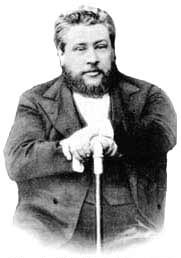
Downgrade controversy
A controversy among the Baptists flared in 1887 with Spurgeon's
first "Down-grade" article, published in The Sword & the Trowel. In the ensuing "Downgrade Controversy" The Metropolitan
Tabernacle became disaffiliated from the Baptist Union, effectuating Spurgeon's congregation as the world's largest self-standing
church and thus a precursor of megachurches of the 20th century. Contextually the Downgrade Controversy was British Baptists'
equivalent of hermeneutic tensions which were starting to sunder Protestant fellowships in general. The Controversy took its
name from Spurgeon's use of the term "Downgrade" to describe certain other Baptists' outlook toward the Bible (i.e., they
had "downgraded" the Bible and the principle of sola scriptura). Spurgeon alleged that an incremental creeping of the Graf-Wellhausen
hypothesis, Charles Darwin's theory of evolution by natural selection, and other concepts was weakening the Baptist Union
and reciprocally explaining the success of his own evangelistic efforts. In the standoff, which even split his pupils trained
at the College, each side accused the other of raising issues which did not need to be raised. The Downgrade Controversy continues.
Final years and death
Often Spurgeon's wife was too ill for her to leave home to hear
him preach. C.H. Spurgeon too suffered ill health toward the end of his life, afflicted by a combination of rheumatism, gout,
and Bright's disease. He often recuperated at Menton, near Nice, France, where he eventually died on 1892 January 31. Spurgeon's
wife and sons outlived him. His remains were buried at West Norwood Cemetery in London were the tomb is still visited by admirers.
|

|

|

